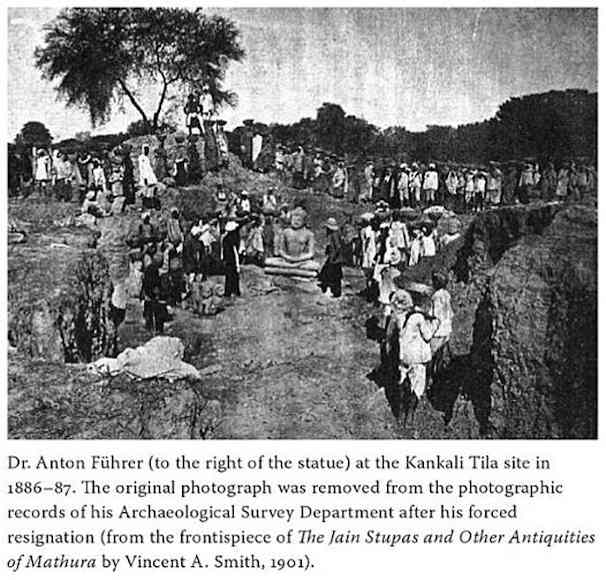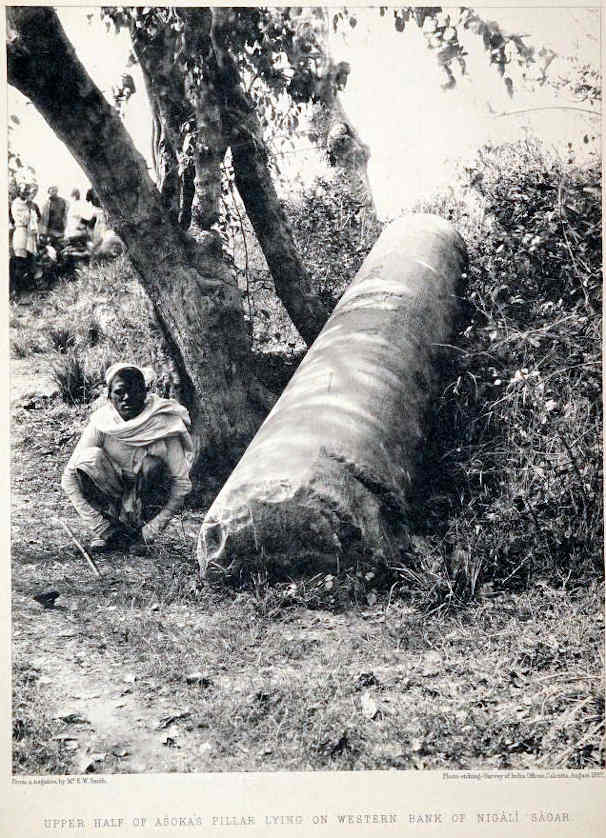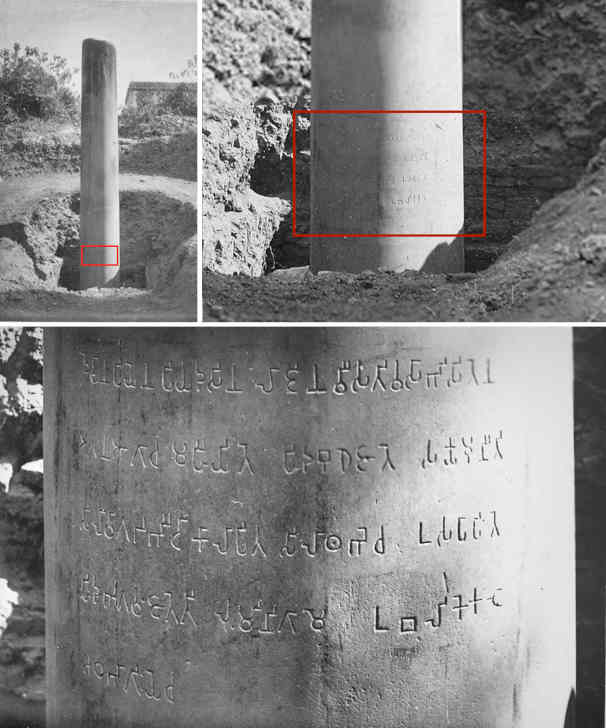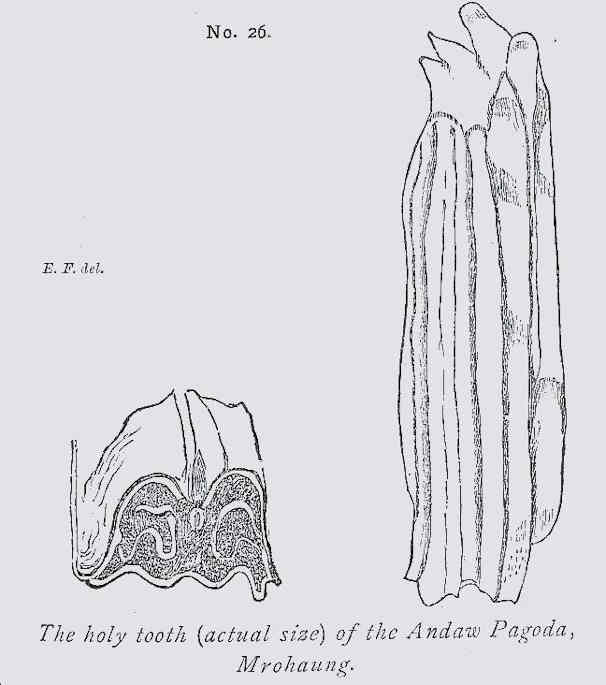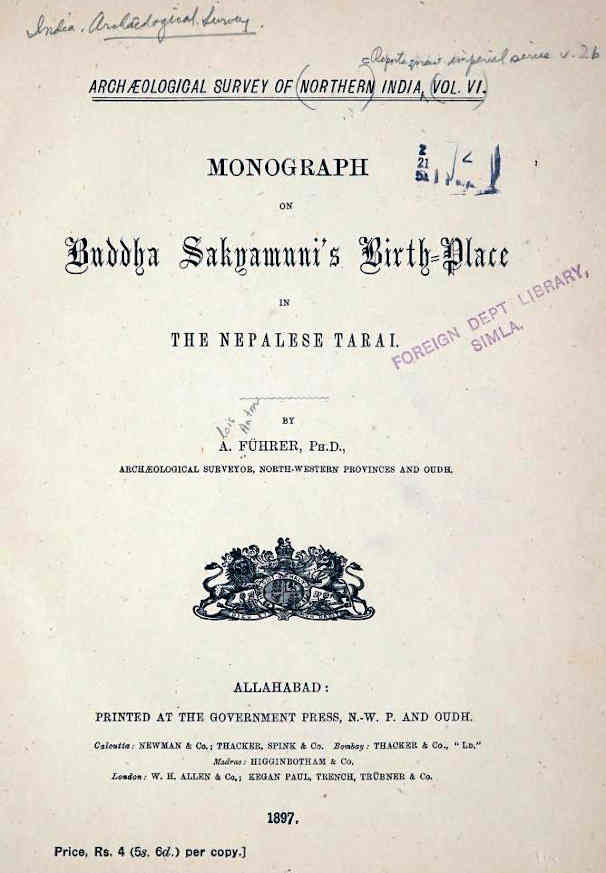Alois Führer was a German Indologist who worked for the British Colonial Archaeological Survey of India. He was born into a German Catholic family. He studied Roman Catholic theology and Oriental studies at the University of Würzburg. His Sanskrit lecturer, Julius Jolly, was associated with the Bombay School of Indology. Probably due to him, he was appointed as a teacher of Sanskrit at the Jesuit St Xavier’s Institute in Bombay (now Mumbai). Führer left the Catholic Church and converted to Anglicanism which cost him his job; he returned to Germany, from where he applied for a new job in the museum in Lucknow in India.
Алоис Фюрер был немецким индологом, работавшим в Британском колониальном Археологическом управлении Индии. Он родился в немецкой католической семье. Он изучал римско-католическую теологию и востоковедение в Вюрцбургском университете. Его лектор по санскриту, Джулиус Джолли, был связан с Бомбейской школой индологии. Вероятно, благодаря ему он был назначен преподавателем санскрита в иезуитский Институт Святого Ксаверия в Бомбее (ныне Мумбаи). Фюрер оставил католическую церковь и перешел в англиканство, что стоило ему работы; он вернулся в Германию, откуда подал заявление на новую работу в музее в Лакхнау в Индии.
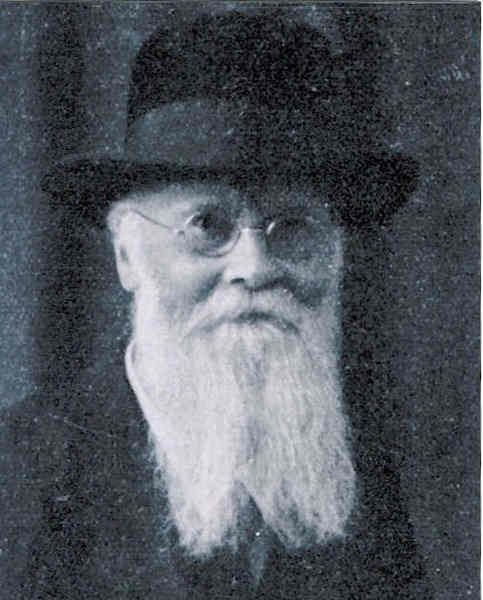
Führer carried out very successful excavations at the Kankali Tila site of Mathura between 1889 and 1891 which improved understanding of the history of Jainism and gained him a reputation “as the most successful of the professional excavators”. In 1891, Führer started excavations at the Ramnagar site of Ahichchhatra.
In 1912, the German Indologist Heinrich Lüders identified in the Lucknow Provincial Museum forged inscriptions in Brahmi on artifacts belonging to Führer’s excavations at Mathura and Ramnagar, forgeries which he attributed to Führer himself. Some of the forged inscriptions were direct copies of inscriptions on other objects, previously published in Epigraphia Indica.
Führer went to Sanchi during the 1891–1892 season and recovered tens of unpublished donative inscriptions, but these could not have the impact he hoped for. Only a new inscription by King Ashoka, for example, could achieve sufficient impact with public opinion.
Фюрер провел очень успешные раскопки в Канкали Тила в Матхуре между 1889 и 1891 годами, которые улучшили понимание истории джайнизма и завоевали ему репутацию “самого успешного из профессиональных раскопщиков”. В 1891 году Фюрер начал раскопки в Рамнагаре на месте Ахиччхатра.
В 1912 году немецкий индолог Генрих Людерс обнаружил в музее провинции Лакхнау поддельные надписи на языке брахми на предметах, относящихся к раскопкам Фюрера в Матхуре и Рамнагаре, подделки, которые он приписал самому Фюреру. Некоторые из поддельных надписей были прямыми копиями надписей на других предметах, ранее опубликованных в Epigraphia Indica.
Фюрер отправился в Санчи в сезон 1891-1892 годов и обнаружил десятки неопубликованных дарственных надписей, но они не смогли оказать того влияния, на которое он рассчитывал. Только новая обнаруженная им надпись царя Ашоки смогла оказать достаточное влияние на общественное мнение.
In 1893–1894, Führer was on a survey tour to Burma. In 1894, he published in his Progress Reports of the Epigraphical Section in the Working Season of 1893–94 the revolutionary discovery of three ancient Gupta inscriptions he said he found at Pagan and Tagaung in Burma, which pushed back the epigraphical knowledge of interactions with India by close to six centuries, generating huge acclaim. He elaborated a detailed description of the inscriptions he had supposedly found, without ever producing a drawing or a photographic proof, although he had a draftsman and a photographer with him on the expedition. Large extracts of his report were reproduced in The Indian Antiquary Vol-xxiv (1895). His “discovery” was taken at face value, and its conclusions repeated by many scholarly works such as the Gazeteer of Upper Burma and the Shan States in 1900, before being adopted by popular works as well.
It was only uncovered many years later that the inscriptions were actually inexistent, a fact which was revealed openly by Charles Duroiselle in 1921: “This Sanskrit inscription never existed, but was invented in toto by Dr Fuhrer while on a tour in Burma”.
The Nigali Sagar pillar (also called “Nigliva” pillar) was initially discovered by a Nepalese officer on a hunting expedition in 1893. In March 1895, Führer inspected the Nigali Sagar pillar, one of the pillars of Ashoka, and identified a Brahmi inscription said to be also from the time of Ashoka.
В 1893-1894 годах Фюрер совершал исследовательскую поездку в Бирму. В 1894 году он опубликовал в своих отчетах о работе эпиграфической секции за рабочий сезон 1893-94 годов революционное открытие трех древних гуптских надписей, найденных, по его словам, в Пагане и Тагаунге в Бирме, которое отодвинуло эпиграфические знания о взаимодействии с Индией почти на шесть веков назад, вызвав огромный резонанс. Он составил подробное описание якобы найденных им надписей, не представив ни рисунка, ни фотографического доказательства, хотя с ним в экспедиции были чертежник и фотограф. Большие выдержки из его отчета были воспроизведены в The Indian Antiquary Vol-xxiv (1895). Его “открытие” было принято за чистую монету, а его выводы повторили многие научные работы, такие как Gazeteer of Upper Burma and the Shan States в 1900 году, а затем их повторили и популярные работы.
Лишь много лет спустя выяснилось, что надписей на самом деле не существовало, и этот факт был открыто разглашен Чарльзом Дюрозелем в 1921 году: “Эта санскритская надпись никогда не существовала, а была полностью выдумана доктором Фюрером во время его поездки в Бирму”.
Столб Нигали Сагар (также называемый “столб Ниглива”) был первоначально обнаружен непальским офицером во время охотничьей экспедиции в 1893 году. В марте 1895 года Фюрер осмотрел столб Нигали Сагар, один из столбов Ашоки, и обнаружил надпись на брахми, которая, как утверждается, также относится ко времени Ашоки.
In 1896, accompanied by the local Nepalese governor, General Khadga Shamsher, Führer discovered a major inscription on a pillar of Ashoka, an inscription which, together with other evidence, confirmed Lumbini as the birthplace of the Buddha. The pillar itself had been known for sometime already, as it had already been reported by Khadga Shamsher to Vincent Arthur Smith a few year earlier. Führer made his great discovery when he dug the earth around the pillar and reported the discovery of the inscription in a pristine state about one meter under the surface.
The authenticity of the discovery has long been doubted, and was openly disputed in a 2008 book by British writer Charles Allen.
Following the discovery of the pillar, Führer relied on the accounts of ancient Chinese pilgrims to search for Kapilavastu, which he thought had to be in Tilaurakot. Unable to find anything, he started excavating some structures he said were stupas, and was in the process of faking pre-Mauryan inscriptions on bricks, when he was caught in the act by Vincent Arthur Smith. The inscriptions were bluntly characterized by Smith as “impudent forgeries”.
В 1896 году в сопровождении местного непальского губернатора, генерала Кхадга Шамшера, Фюрер обнаружил крупную надпись на столбе Ашоки, надпись, которая, вместе с другими доказательствами, подтвердила, что Лумбини является местом рождения Будды. Сам столб был известен уже некоторое время, так как о нем сообщил Кхадга Шамшер Винсенту Артуру Смиту несколькими годами ранее. Фюрер сделал свое великое открытие, когда раскопал землю вокруг столба и сообщил об обнаружении надписи в нетронутом виде на глубине около одного метра под поверхностью.
Подлинность находки долгое время вызывала сомнения, и была открыто оспорена в книге 2008 года британского писателя Чарльза Аллена.
После обнаружения столба Фюрер полагался на рассказы древних китайских паломников в поисках Капилавасту, который, по его мнению, должен был находиться в Тилауракоте. Не найдя ничего, он начал раскопки некоторых сооружений, которые, по его словам, были ступами, и как раз занимался подделкой домавританских надписей на кирпичах, когда его поймал на месте преступления Винсент Артур Смит. Надписи были прямо названы Смитом “наглыми подделками”.
Around the same time, Führer was selling fake relics “authentified” but an inexistent inscription of Upagupta, the preceptor of Ashoka, to Shin U Ma, an important monk in Burma. He wrote to the Burmese monk: “Perhaps you have seen from the papers that I succeeded in discovering the Lumbini grove where Lord Buddha was born”, noting that “you have unpacked the sacred relics of our Blessed Lord Buddha which are undoubtedly authentic, and which will prove a blessing to those which worship them faithfully”. An “authentic tooth relics of the Buddha” sent by Führer in 1896 turned out to have been carved from a piece of ivory, and another sent in 1897 was that of a horse. The forgery was reported in 1898 to the British North-Western Provinces Government in India by Burmologist and member of the Burma commission Bernard Houghton, and started an enquiry which would lead to Führer’s resignation on 16 September 1898.
In January 1898, Führer was again involved in a major discovery, that of the reliquaries at Piprahwa.
According to the New York Post (3 May 1896) the Nigliva discovery “seems to carry the origin of Buddhism much further back”. The Liverpool Mercury (29 December 1896) reports that the discovery that Lumbini (also called Paderia) was “the actual birthplace of the Buddha ought to bring devout joy to about 627,000,000 people”. The Pall Mall Gazette (18 April 1898) related that the Piprahwa discovery “contains no less a relic than the bones of the Buddha himself”.
Примерно в то же время Фюрер продавал поддельные мощи, “заверенные” несуществующей надписью Упагупты, предшественника Ашоки, Шин У Ма, высокопоставленному монаху в Бирме. Он писал бирманскому монаху: “Возможно, вы видели из газет, что мне удалось обнаружить рощу Лумбини, где родился Господь Будда”, отметив, что “распаковали священные мощи нашего Благословенного Господа Будды, которые, несомненно, являются подлинными, и которые окажутся благословением для тех, кто преданно им поклоняется”. “Останки подлинного зуба Будды”, отправленные Фюрером в 1896 году, оказались вырезанным из куска слоновой кости, а другие, отправленные в 1897 году, был лошадиными. О подделке в 1898 году сообщил британскому правительству Северо-Западных провинций в Индии бирмолог и член комиссии по Бирме Бернард Хоутон, и началось расследование, которое привело к отставке Фюрера 16 сентября 1898 года.
В январе 1898 года Фюрер снова участвовал в крупном открытии – реликвариях в Пипрахве.
Согласно газете New York Post (3 мая 1896 года), открытие в Нигливе “кажется, переносит происхождение буддизма намного дальше в прошлое”. Liverpool Mercury (29 декабря 1896 года) сообщал, что открытие того, что Лумбини (также называемый Падерией) был “фактическим местом рождения Будды, должно принести набожную радость примерно 627 000 000 человек”. Газета Pall Mall Gazette (18 апреля 1898 года) сообщила, что находка в Пипрахве “содержит не меньшую реликвию, чем кости самого Будды”.
Führer’s archaeological career ended in disgrace. Führer came under suspicion from March 1898 following the reported forgeries of the Buddha’s relics.
A formal inquiry was launched into his activities, but officials struggled to find a “printable” reason for Führer’s dismissal. Führer was officially confronted by Vincent Arthur Smith, who reported the forgeries of the Buddha’s relics. Führer was exposed as “a forger and dealer in fake antiquities”. Smith also blamed Führer for administrative failures in filing his reports to the Government, and for a false report about his preparations for future publications on his archaeological research: Führer was obliged to admit “that every statement in it [the report] was absolutely false.” The false inscriptions supposed to authentify the Buddha relics were not mentioned in the investigations, apparently out of fear of casting doubt on the other epigraphical discoveries made by Führer.Similarly, the false publication of the ancient Burmese inscriptions, were the object of an institutional cover-up, which would not come to light before 1921, with the revelation of their inexistence made by Charles Duroiselle.
In 1901, Vincent Arthur Smith, after retirement, chose to reveal the blunt truth about the Nepalese discoveries and published a stark analysis of Führer’s activities, apparently worried that “the reserved language used in previous official documents has been sometimes misinterpreted”. In particular, Smith said of Führer’s description of the archaeological remains at Nigali Sagar that “every word of it is false”, and characterized several of Führer’s epigraphic discoveries as “impudent forgeries”. However Smith never challenged the authenticity of the Lumbini pillar inscription and the Nigali Sagar inscription discovered by Führer.
Under official instructions from the Government of India, Führer’s resignation was accepted and he was relieved of his positions, his papers seized and his offices inspected by Vincent Arthur Smith on 22 September 1898. Führer had written in 1897 a monograph on his discoveries in Nigali Sagar and Lumbini, Monograph on Buddha Sakyamuni’s birth-place in the Nepalese tarai, which was withdrawn from circulation by the Government.
Археологическая карьера Фюрера закончилась позором. Фюрер попал под подозрение с марта 1898 года после сообщений о подделке мощей Будды.
Было начато официальное расследование его деятельности, но чиновники с трудом нашли “вескую” причину для увольнения Фюрера. Фюреру официально предъявил претензии Винсент Артур Смит, который сообщил о подделке мощей Будды. Фюрер был разоблачен как “фальсификатор и торговец поддельными древностями”. Смит также обвинил Фюрера в административных нарушениях при подаче отчетов правительству и в ложной информации о подготовке будущих публикаций о его археологических исследованиях: Фюрер был вынужден признать, “что каждое утверждение в нем [отчете] было абсолютно ложным”. Фальшивые надписи, которые должны были подтвердить подлинность мощей Будды, не упоминались в расследовании, очевидно, из опасения поставить под сомнение другие эпиграфические открытия, сделанные Фюрером. Аналогичным образом, фальшивая публикация древних бирманских надписей была объектом институционального сокрытия, которое стало известно только в 1921 году, когда Чарльз Дюрозель раскрыл их несуществование.
В 1901 году Винсент Артур Смит, выйдя в отставку, решил раскрыть правду о непальских открытиях и опубликовал резкий анализ деятельности Фюрера, очевидно, обеспокоенный тем, что “сдержанный язык, использовавшийся в предыдущих официальных документах, иногда неправильно интерпретировался”. В частности, Смит сказал об описании Фюрером археологических останков в Нигали Сагар, что “каждое слово в нем – ложь”, и охарактеризовал несколько эпиграфических открытий Фюрера как “наглые подделки”. Однако Смит никогда не оспаривал подлинность надписи на столбе Лумбини и надписи в Нигали Сагар, обнаруженной Фюрером.
Согласно официальным инструкциям правительства Индии, отставка Фюрера была принята, и он был освобожден от занимаемых должностей, его бумаги конфискованы, а его кабинеты осмотрены Винсентом Артуром Смитом 22 сентября 1898 года. В 1897 году Фюрер написал монографию о своих открытиях в Нигали Сагар и Лумбини “Монография о месте рождения Будды Шакьямуни в непальском тарае“, которая была изъята из обращения правительством.
Führer was dismissed and returned to Europe with his family. He died on 5 November 1930 in Binningen, Switzerland.
Führer had an unusual religious career. He served as a Catholic priest, but in 1887 converted to Anglicanism. Following his expulsion from government service in India, Führer made plans to become a Buddhist monk. Quoting the Ceylon Standard, the Journal of the Mahabodhi Society noted: “Much interest has been excited in Buddhist and other circles at the prospect of Dr Führer coming to Ceylon to join the Buddhist priesthood. The Press notices recently made regarding this gentleman have given rise to grave suspicion. We understand that Dr Führer will have an opportunity given him of refuting the charges made against him before he is accepted by the leading Buddhists here as an exponent of the religion of Buddha.”These plans seem to have come to nothing because in 1901 Führer re-converted to the Christian Catholic Church of Switzerland and worked as a priest from 1906 to 1930.
Despite the exposure of many forgeries of Führer, for example, the temple complex in Lumbini still remains a place of pilgrimage for Buddhists, as the birthplace of Buddha. Despite the fact that the inscription of King Ashoka stating this is known in academic circles as a fake, if we exclude walking pilgrims from India, then Lumbini is now visited by about 100 thousand tourists a year.
In addition, Alois Führer distinguished himself not only by the discovery of the birthplace of the Buddha, but also the birthplace of Krishna: the Keshava Dev temple was erected on the site of a burial mound excavated by the Führer, where he discovered the foundation and the “confirmation inscription”. True, it is still trying not to remember this significant contribution to the antiquity of Hinduism by Führer, and his contemporaries seized the corresponding photo documents about the authorship of archaeological research in Mathura after his exposure of falsifications in the field of Buddhism.
Фюрер был уволен и вернулся в Европу со своей семьей. Он умер 5 ноября 1930 года в Биннингене, Швейцария.
У Фюрера была необычная религиозная карьера. Он служил католическим священником, но в 1887 году перешел в англиканство. После изгнания с государственной службы в Индии Фюрер планировал стать буддийским монахом. Цитируя “Цейлон Стандарт”, журнал “Общество Махабодхи” отмечало: “Большой интерес в буддийских и других кругах вызвала перспектива приезда доктора Фюрера на Цейлон для вступления в буддийское священство. Недавно появившиеся в прессе сообщения об этом джентльмене вызвали серьезные подозрения. Мы понимаем, что доктору Фюреру будет предоставлена возможность опровергнуть выдвинутые против него обвинения, прежде чем он будет принят ведущими буддистами здесь в качестве представителя религии Будды”. Эти планы, похоже, не оправдались, потому что в 1901 году Фюрер вновь обратился в христианскую католическую церковь и работал священником в Швейцарии с 1906 по 1930 год.
Несмотря на разоблачение многих подделок Фюрера, к примеру, храмовый комплекс в Лумбини до сих пор остается местом паломничества буддистов, как место рождения Будды. Несмотря на то, что надпись царя Ашоки, утверждающая это, в академических кругах известна как подделка, если исключить пеших паломников из Индии, то Лумбини сейчас посещают около 100 тысяч туристов в год.
Кроме того, Алоис Фюрер отличился не только обнаружением места рождения Будды, но и места рождения Кришны: храм Кешава Дев был возведен на месте кургана, раскопанного Фюрером, где он обнаружил фундамент и “подтверждающую надпись”. Правда, этот значимый вклад в древность индуизма Фюреру до сих пор стараются не вспоминать, а его современники изымали соответствующие фото-документы об авторстве археологических изысканий в Матхуре после его разоблачения фальсификаций в области буддизма.
Related materials:
Mr Houghton and Dr Führer: A Scholarly Vendetta and its Consequences – #^https://doi.org/10.5367/sear.2011.0030
“Buddha was born in Nepal” – Dr. Alois Anton Führer says. “He is a big lier” – Indian government says – #^http://buddhalivedinsrilanka.blogspot.com/2013/05/buddha-was-born-in-nepal-dr-anton.html
Lumbini On Trial: The Untold Story – #^http://www.sljaki.com/related/phelps-lumbini.html
via Александра Гринин, Тайнам Нет
#archeology #asia #buddha #buddhism #europe #colonialism #forgery #hinduism #history #hoax #jesuit #india #krishna #nepal #property #religion #revision
